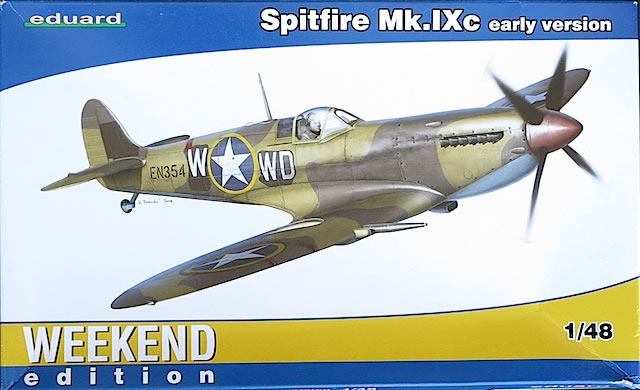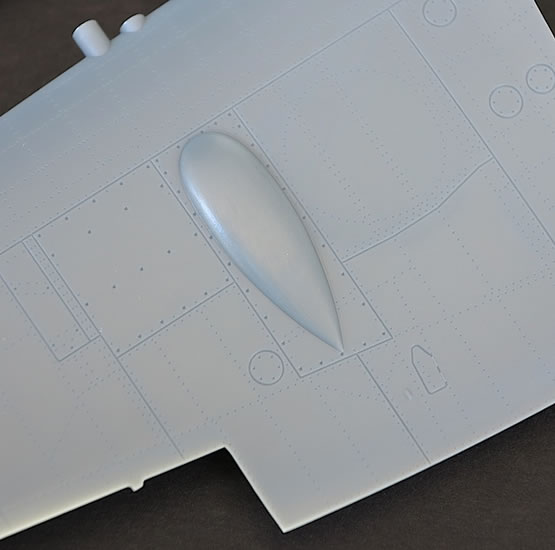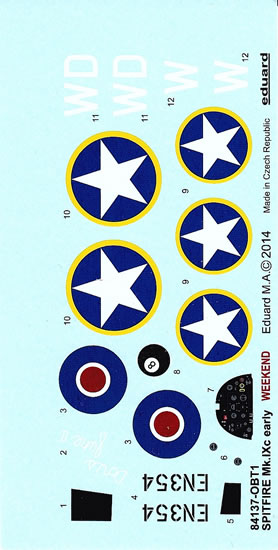|
Spitfire Mk.IXc
Early Version
Weekend Edition

Eduard, 1/48 scale
S
u m m a r y |
| Catalogue Number: |
Eduard kit no.84137 – Spitfire Mk.IXc Early Version Weekend Edition |
| Scale: |
1/48 |
| Contents and Media: |
Approximately 191 grey plastic parts (56 unused); 14 clear plastic parts (6 unused); 1 decal sheet containing markings for 1 aircraft; 12 page instruction booklet with full colour painting and marking guide |
| Price: |
USD$25.46 plus shipping available online from Eduard’s website
and specialist hobby retailers worldwide |
| Review Type: |
FirstLook |
| Advantages: |
Accurate and well-engineered kit; high quality plastic parts with excellent detail; interesting marking option; good instructions and decals. |
| Disadvantages: |
Yellow border on US national insignia decals appears to be slightly out of register. |
| Conclusion: |
These Weekend Edition boxings are a value-for-money way of obtaining an Eduard Mk.IX, which even without the photo-etched parts of a Profipack boxing builds into an accurate and detailed model. Eduard’s interesting choice of marking option for this early version boxing, and the inclusion of a full-colour painting and marking guide, are added bonuses – highly recommended. |
Reviewed by Brad Fallen

Eduard's 1/48 scale Spitfire Mk.IXc Weekend Edition is available online from Squadron.com
The Spitfire Mk.IX first flew in February 1942. When deployed on the Channel Front four months later it was immediately effective against the Focke-Wulf Fw 190, and began to steadily replace the Mk.V in RAF service. Mk.IXs were also supplied to allies such as the Soviet Union and the United States; for example the Twelfth Air Force’s 52nd Fighter Group flew them in the Mediterranean in 1943-44. Many 52nd FG Mk.IXs were camouflaged in Dark Earth and Middle Stone over Azure Blue, and some for a time wore RAF roundels and fin flashes in addition to their USAAF markings.
These Spitfires are interesting modeling subjects, and it is pleasing that Eduard has chosen a 52nd FG aircraft as the subject of its recent 1/48 Weekend Edition Mk.IXc early version kit – specifically EN354/WD-W/‘Doris June II’, flown by 1st Lt. Leonard V. Helton of the 4th Fighter Squadron based at La Sebala, Tunisia, in June 1943. According to Andrew Thomas in Osprey’s ‘American Spitfire Aces of World War 2’, Helton claimed two victories in EN354 in April and August 1943. As is often the case with Weekend Edition kits, this marking option is drawn from one of Eduard’s earlier Profipack boxings – in this case the Spitfire Mk.IXc early version kit that was reviewed by Brett Green in February 2014.
The box top features an attractive painting of EN354 in flight, superimposed on the usual blue, white and yellow background of Weekend Edition kits. Full colour port and starboard profiles and upper and lower views have been printed on the box sides – also standard for Weekend Edition kits – but as we shall see later these are superfluous for this release.
Inside are four sprues of dark grey plastic and one sprue of clear plastic. Grey sprue B provides wings with the wide cannon blisters that characterised many early Mk.IXcs. I haven’t been able to find a photo of EN354 that shows the upper wing surfaces, but the aircraft’s serial number suggests the wide blisters were likely to have been fitted. The remaining grey sprues (E, F and G) contain optional elevators, horizontal tailplanes, rudders, exhausts, wheel hubs and other parts that will allow you to complete your model as an early, mid or late production Mk.IX.
Only parts for an early version are needed here, so you will have plenty of spares for future projects.
All of the sprues are beautifully moulded with just a tiny amount of flash on some of the smaller parts – unsurprising for moulds that are only 18 or so months old. The surface detail on the larger parts is gorgeous (there is no other way to describe it) with restrained, consistent panel lines and riveting.

All control surfaces except the flaps are provided as separate parts, which is a sensible compromise by Eduard as Spitfire flaps were rarely seen extended when aircraft were on the ground. If you do want to build your model with flaps deployed, Eduard has designed a photo-etched set specifically for this kit.
Interior detail is good, regardless of the absence of photo-etched brass, with the cockpit built up from nearly 40 parts. The four-part pilot’s seat looks convincing, but can be further improved with some aftermarket etched or fabric harnesses. Two options are provided for the instrument panel – a plastic panel with finely raised dials that will benefit from careful painting or the addition of individually punched decal dials, or a flat panel to which a single decal is applied. Don’t try to place this decal over the panel with raised details, however, as the dials on each are in slightly different locations.
A feature I noticed for the first time when examining this kit, but which has presumably always been present on Eduard’s 1/48 Spitfires, is the provision in the port fuselage half for removing the radio compartment door. Lines have been engraved inside the fuselage to make this process as straightforward as possible, should you wish to install the separately available Brassin radio compartment set.
Assembly is called out in a 12-page A4 booklet; this is largely black-and-white, although to assist with construction joining surfaces between parts are highlighted in blue. The instructions are clearly set out, and the suggested order of assembly is sensible. Gunze Sangyo paints are used for colour call outs.
Marking
EN354 was finished in Dark Earth/Middle Stone over Azure Blue, with evidence of overpainted (presumably RAF) markings on the fuselage, wings and vertical tail surfaces. Yellow-bordered US insignia were carried on the fuselage sides, both upper wings and possibly the lower starboard wing, with an RAF Type C roundel on the lower port wing and perhaps the lower starboard (a spare roundel is supplied if you want to depict your model like this). The spinner was red, and the fuselage code letters white.

The instructions make these colours easy to interpret because, unusually for a Weekend Edition kit, they include a full-colour painting and marking guide. Four-view drawings are provided, along with a front view of the propeller blades and spinner. Gunze Sangyo paints are used for colour call outs both here and earlier in the instruction booklet, during construction.
The decals have been printed by Eduard and are mostly OK. The font and size of the ‘WD-W’ code letters match those on the real aircraft, as does the cursive script of ‘Doris June II’. Unfortunately the yellow border on most if not all of the US national insignia appears to be slightly out of register, a problem that is tricky to fix; hopefully it’s an error that is limited to the review sample.
No stencils are provided, but if you don’t have any spares in your decal bank, then once again Eduard has released a set specifically for its Spitfire Mk.IX kits.
This is Eduard’s second Weekend Edition boxing of its 1/48 Mk.IX kit, following the earlier Mk.IXc late version kit reviewed here. A Mk.IXe Weekend Edition has now also been released, with more certain to follow. All are value-for-money ways of obtaining an Eduard Mk.IX, which even without the photo-etched parts of a Profipack boxing can be built into an accurate and detailed model. Eduard’s interesting choice of marking option for this early version boxing, and the inclusion of a full-colour painting and marking guide, are added bonuses – highly recommended.
References:
-
Robert Humphreys, ‘The Supermarine Spitfire – A Comprehensive Guide for the Modeller, Part 1: Merlin Powered’ (SAM Publications, 2000)
-
Andrew Thomas, ‘American Spitfire Aces of World War 2’ (Osprey 2007)
-
Eighth Air Force Historical Society website
Thanks to Eduard for the sample
Review Text and Images Copyright © 2014 by Brett Green
Page Created 28 July, 2014
Last updated
28 July, 2014
Back to HyperScale Main Page
Back to Reviews Page |
